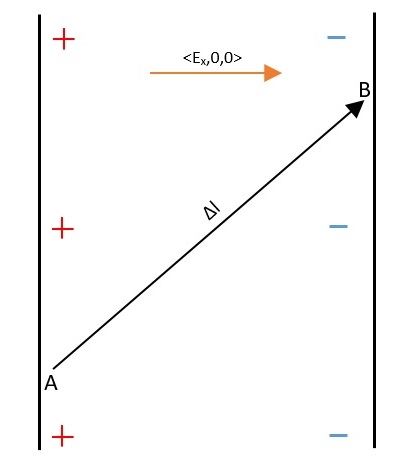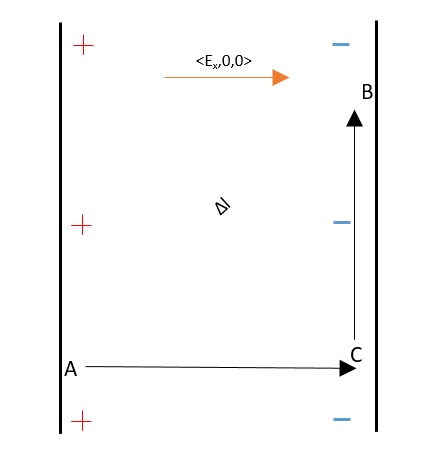Path Independence of Electric Potential: Difference between revisions
No edit summary |
No edit summary |
||
| Line 83: | Line 83: | ||
=Example 2= | =Example 2= | ||
[[File: | [[File:Final.jpg]] | ||
The above problem deals with a triple-plated, double-spaced, and parallel-plated capacitor and the associated potential difference as you cross over the center plate. Note that, intuitively, the electric fields are only multiplied by the portion of the path that falls within their respective capacitor space. They are then summed. This problem also deals with potential difference when path is reversed. | The above problem deals with a triple-plated, double-spaced, and parallel-plated capacitor and the associated potential difference as you cross over the center plate. Note that, intuitively, the electric fields are only multiplied by the portion of the path that falls within their respective capacitor space. They are then summed. This problem also deals with potential difference when path is reversed. | ||
Revision as of 16:22, 27 November 2016
Claimed by Josh Whitley Spring 2016, Edited by Emilie Pourchet Fall 2016
The concept of potential difference relies on what we call "Path Independence". This means that the path taken between the two observed locations does not affect the potential difference between the two locations. Therefore, any path can be taken to calculate the potential difference between two points. This can be very useful in some calculations, as will be shown later.
The Main Idea
What is Electric Potential?
In order to understand why the electric potential difference is path independent, it can be helpful to define electric potential.
Electric potential is the amount of electric potential energy that a point charge would have if it was located at some point in space (point B in this wiki page is how I will refer to this point in space), relative to an arbitrary reference point (point A). It equals the work done by a constant external force in carrying the charge from point A to point B. Note that this does mean moving a point charge around in space before returning it to its original location means both the work done and the potential equal 0. Electric potential is measured in volts or Joules/Coulomb. Electric potential at infinity is effectively 0.
What is Path Independence?
Electric potential, as stated above, is entirely independent of the path taken to get from an initial to final state. When presented with a complex path from one point to another, choosing the easiest path (a straight line connecting the two points) can simplify the problem while still yielding the correct answer as a result of this principle.
Note that path independence holds true for all potential energy, not just electric potential. For that reason, a useful frame of reference is the path independence of physical objects' potential energy in a gravitic field that is introduced in physics 1 - electric potential path independence functions the same way.
A Mathematical Model
The general representation of electric potential is the following:
[math]\displaystyle{ \triangle V = V_b-V_a }[/math]
This formula can be expanded by summing the different components of the change in position within electric field components to calculate the change in electric potential. This equation is useful for proving path independence as it can be applied to multi-step path in straight line increments, proving when compared to a direct path that the change in electric potential is the same.
[math]\displaystyle{ \triangle V = -(E_x \triangle x, E_y \triangle y, E_z \triangle z) }[/math]
A Computational Model
Click the above link to go to a GlowScript page that details Path Independence of Electric Potential. Point A is marked by a green sphere, Point B is marked by a red sphere, moving negative particle 1 is marked by a blue sphere and trail, while moving negative particle 2 is marked by a white sphere and trail. Remember to scroll down in the display window to make sure you've seen the most recent printed value!
In this simulation, you can:
1) Click the display window to progress the simulation, which will print a change in electric potential below corresponding to the parameters of your electric field and the size of your movement. By default, the electric field is (-50,0,0) N/C and the steps are arbitrary and simply designed to show a progression from point A to B by the particle.
2) See how two different paths (one blue and one white) result in the same change in electric potential, regardless of their stark differences in path length.
Note that if you have difficulty seeing the simulation or the printed values, you can navigate to the menu in the top left of the coding window (represented by three parallel bars) and engage a fullscreen mode. Note also that the default code is set to use an electric field with only an x component, for simplicity. Changes in the size of the movement steps are not supported.
Examples
Example 1
Below is an example that demonstrates the path independence of electric potential difference.
Let's calculate the potential difference between A and B in the first scenario. Assume that the height difference between A and B is y and the x component increases by x.
[math]\displaystyle{ \triangle V= -(E_x \triangle x, E_y \triangle y, E_z \triangle z) }[/math]
[math]\displaystyle{ \triangle V= -E_x(x_1-0) + 0(y_1-0) + 0*0 }[/math]
[math]\displaystyle{ \triangle V = -E_xx_1 }[/math]
In the second scenario, let's divide this process into two parts to follow the path outlined from A to C and from C to B.
From A to C:
[math]\displaystyle{ \triangle V = -(E_x \triangle x, E_y \triangle y, E_z \triangle z) }[/math]
[math]\displaystyle{ \triangle V = -E_x(x_1-0)+ 0*0 + 0*0 }[/math]
[math]\displaystyle{ \triangle V = -E_xx_1 }[/math]
From C to B:
[math]\displaystyle{ \triangle V = -(E_x \triangle x, E_y \triangle y, E_z \triangle z) }[/math]
[math]\displaystyle{ \triangle V = -E_x*0 + 0*(y-0) + 0*0 }[/math]
[math]\displaystyle{ \triangle V = 0 }[/math]
Now let's calculate the TOTAL potential difference for this scenario, it is the sum of the potential differences from A to B and from B to C.
[math]\displaystyle{ \triangle V_{A to B} = \triangle V_{A to C} + \triangle V_{C to B} }[/math]
[math]\displaystyle{ \triangle V_{total} = -E_xx_1 + 0 = -E_xx_1 }[/math]
We can see that the results for both scenarios are the same, therefore the electric potential difference is independent of the path taken to calculate it.
Example 2
The above problem deals with a triple-plated, double-spaced, and parallel-plated capacitor and the associated potential difference as you cross over the center plate. Note that, intuitively, the electric fields are only multiplied by the portion of the path that falls within their respective capacitor space. They are then summed. This problem also deals with potential difference when path is reversed.
In order to make this problem demonstrate Path Independence specifically, simply take a new path from A to B (by creating points in between) and calculate the displacement components times the corresponding electric field component of those mid points instead of the direct A to B path. You will find that all Y and Z components equal 0, which leaves only the X component of the path to be calculated. This will inevitably end up with the same potential difference as what is done above.
Connectedness
How is this topic connected to something that you are interested in? How is it connected to your major?
Spontaneous redox reactions often cause a potential disparity that can drive batteries. Electrochemistry, a subset of chemistry that I am interested in as an aspiring chemical engineer, spends a significant amount of time focusing on these interactions and the electrical output of different reaction combinations. In a sense, understanding the physics side of electrical potential helps round out my understanding of electrochemistry.
Is there an interesting industrial application?
In terms of strictly applying the idea of path independence, I would argue there is no industrial application. Though I would argue that related fields, such as electrochemistry, have sweeping industrial applications. The optimization of batteries relies partially on finding half reaction combinations that yield the largest positive potential. It's just that strictly dealing with path independence doesn't leave much room for innovation or invention - you need to involve related ideas. Perhaps the pathing of chemicals inside of a battery is made moot by this principle.
History
Around 1800 an Italian doctor named Luigi Galvani found that touching a frog's leg to two different metals caused it to twitch. Alessandro Volta, a contemporary and rival or Galvani, studied these findings and concluded that a kind of electrical potential difference between the two metals caused a charge to flow through the frog's leg, firing the muscles to ultimately create a post-mortem twitch.
Volta found that, in the presence of significant electrical potential between two metals, electrical charge can flow through a metal wire (and through frog legs, salinated brine, etc). The analogy of the time was that current flowed through wire similarly to water in a pipe. Because of this discovery, Volta lives on through the concept of voltage and the associated unit of measurement - the volt.
See also
https://en.wikipedia.org/wiki/Voltage#See_also
https://en.wikipedia.org/wiki/Electric_potential
https://www.insidescience.org/content/soccers-electric-potential/1022
http://jes.ecsdl.org/content/147/11/4263.abstract
http://farside.ph.utexas.edu/teaching/302l/lectures/node32.html
http://faculty.cua.edu/sober/611/PATHIND.pdf
http://scienceline.ucsb.edu/getkey.php?key=4026
References
Matter & Interactions volume II by Ruth W. Chabay and Bruce A. Sherwood.
Chapter 16 Webassign Review


